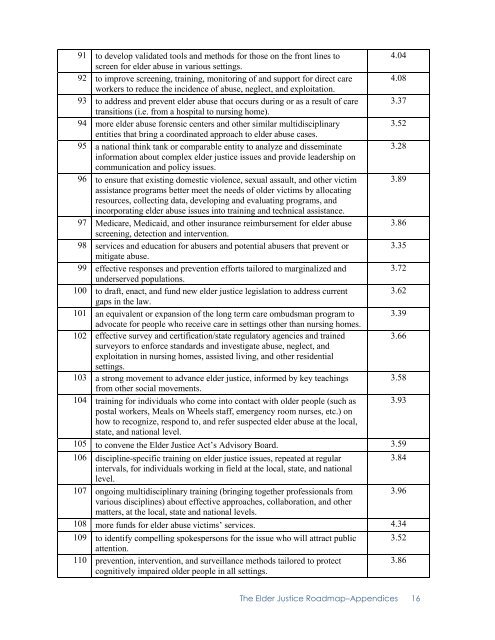The Elder Justice Roadmap
2gJRXoo
2gJRXoo
Create successful ePaper yourself
Turn your PDF publications into a flip-book with our unique Google optimized e-Paper software.
91 to develop validated tools and methods for those on the front lines to<br />
4.04<br />
screen for elder abuse in various settings.<br />
92 to improve screening, training, monitoring of and support for direct care 4.08<br />
workers to reduce the incidence of abuse, neglect, and exploitation.<br />
93 to address and prevent elder abuse that occurs during or as a result of care 3.37<br />
transitions (i.e. from a hospital to nursing home).<br />
94 more elder abuse forensic centers and other similar multidisciplinary<br />
3.52<br />
entities that bring a coordinated approach to elder abuse cases.<br />
95 a national think tank or comparable entity to analyze and disseminate<br />
3.28<br />
information about complex elder justice issues and provide leadership on<br />
communication and policy issues.<br />
96 to ensure that existing domestic violence, sexual assault, and other victim 3.89<br />
assistance programs better meet the needs of older victims by allocating<br />
resources, collecting data, developing and evaluating programs, and<br />
incorporating elder abuse issues into training and technical assistance.<br />
97 Medicare, Medicaid, and other insurance reimbursement for elder abuse 3.86<br />
screening, detection and intervention.<br />
98 services and education for abusers and potential abusers that prevent or 3.35<br />
mitigate abuse.<br />
99 effective responses and prevention efforts tailored to marginalized and 3.72<br />
underserved populations.<br />
100 to draft, enact, and fund new elder justice legislation to address current 3.62<br />
gaps in the law.<br />
101 an equivalent or expansion of the long term care ombudsman program to 3.39<br />
advocate for people who receive care in settings other than nursing homes.<br />
102 effective survey and certification/state regulatory agencies and trained<br />
3.66<br />
surveyors to enforce standards and investigate abuse, neglect, and<br />
exploitation in nursing homes, assisted living, and other residential<br />
settings.<br />
103 a strong movement to advance elder justice, informed by key teachings 3.58<br />
from other social movements.<br />
104 training for individuals who come into contact with older people (such as 3.93<br />
postal workers, Meals on Wheels staff, emergency room nurses, etc.) on<br />
how to recognize, respond to, and refer suspected elder abuse at the local,<br />
state, and national level.<br />
105 to convene the <strong>Elder</strong> <strong>Justice</strong> Act’s Advisory Board. 3.59<br />
106 discipline-specific training on elder justice issues, repeated at regular<br />
3.84<br />
intervals, for individuals working in field at the local, state, and national<br />
level.<br />
107 ongoing multidisciplinary training (bringing together professionals from 3.96<br />
various disciplines) about effective approaches, collaboration, and other<br />
matters, at the local, state and national levels.<br />
108 more funds for elder abuse victims’ services. 4.34<br />
109 to identify compelling spokespersons for the issue who will attract public<br />
attention.<br />
110 prevention, intervention, and surveillance methods tailored to protect<br />
cognitively impaired older people in all settings.<br />
3.52<br />
3.86<br />
<strong>The</strong> <strong>Elder</strong> <strong>Justice</strong> <strong>Roadmap</strong>–Appendices 16


